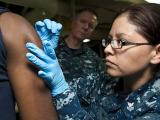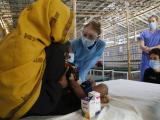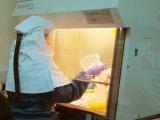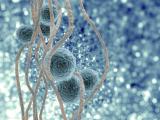Oct 10, 2003 (CIDRAP News) – The National Research Council (NRC) this week proposed a plan to expand and formalize the system for screening research proposals in order to keep biotechnology from playing into the hands of terrorists.
The plan would expand the responsibilities of existing screening committees at research institutions and would set up a new national board to oversee the screening system. And whereas the existing screening program officially covers only research projects funded by the National Institutes of Health (NIH), the new proposal envisions extending the screening to potentially risky projects funded by industry and other non-NIH sources.
"The crux of the dilemma is the technology that protects can also be used to harm," said Gerald Fink, chair of the NRC committee that wrote the screening proposal, in introducing the plan at an Oct 8 briefing. The 16-member committee offered its plan in a 100-page report titled "Biotechnology Research in an Age of Terrorism: Confronting the 'Dual Use' Dilemma."
"This proposal is a key step in an evolving process to strike the right balance between national security concerns and the openness necessary for America's research enterprise to thrive," Fink stated in a news release from the National Academies, the NRC's parent organization. Fink is a professor of genetics at the Massachusetts Institute of Technology and member of the Whitehead Institute for Biomedical Research.
In the briefing, Fink said the possible misuse of biotechnology includes two types of threats: that pathogens that are being studied will be stolen or diverted for malevolent purposes, and that "research results could facilitate the creation of novel pathogens or threat agents for use by hostile parties."
In focusing on the likeliest dangers, the NRC committee identified seven classes of experiments that it felt should be screened by experts. These are experiments that would:
- Demonstrate how to render human or animal vaccines ineffective
- Make pathogens resistant to useful antibiotics or antiviral agents for humans, animals, or crops
- Enhance the virulence of human, animal, or plant pathogens, or make nonpathogens virulent
- Increase the transmissibility of pathogens
- Change the host range of pathogens
- Enable pathogens to evade diagnostic or detection methods
- Facilitate the weaponization of biological agents or toxins
The report proposes a tiered system for screening research proposals, according to the news release and committee members. The first tier consists of the existing "Institutional Biosafety Committee" (IBC) at individual research institutions. Following NIH guidelines, IBCs currently review research proposals involving recombinant DNA. The report says IBCs' responsibilities should be expanded to include all experiments in the seven classes of concern.
Most of the time IBCs would be able to decide on their own whether to allow a project to proceed, the NAS said. If an IBC couldn't decide on a project, it would refer the case to the NIH's Recombinant DNA Advisory Committee (RAC) and possibly to the director of the NIH. In making a decision, the RAC and NIH director could consult with the proposed new national board, the "National Science Advisory Board for Biodefense."
The national board would consist of top scientists and national security experts, according to the news release. Besides giving advice on the relative risks and benefits of new technologies, the board could alert the government to new opportunities for developing vaccines and antibiotics, officials said. The board would also "promote ongoing dialogue between scientists and security experts."
Under the NRC proposal, the IBC-RAC screening system would begin to cover some research projects not funded by the NIH, the NAS said. The RAC's current jurisdiction officially includes only NIH-funded research, but a number of government agencies and private firms voluntarily participate in the screening system, officials said.
At the news briefing, committee members said they are not advocating a legal requirement that all potentially risky research proposals be screened. Committee member Ronald Atlas, a professor of biology at the University of Louisville, said "industry has always been cooperative" with regard to screening of research plans. "There is an expectation that everyone is going to want to join in this effort, and that is what we want to build upon," he said. "We want to prevent the subversion of the research endeavor, and we are providing prudent steps that should not be overly burdensome. . . . In essence, I don't think that statutory authority is going to be necessary to get the system to work."
The proposed system would also include review of the results of any experiments of concern that are approved. "But the issue of whether these results should be published needs to be resolved within the scientific community, not by government policy," said Fink. "Vigilant self-governance is the goal."
The news release said the establishment of a system for dealing with publication decisions requires an ongoing discussion among journal editors and between editors and national security experts. The proposed National Science Advisory Board for Biodefense could be an important resource for journal editors facing difficult publication decisions, officials said.
In other recommendations, the report urges scientific societies to create programs to educate life scientists about the risks involved in advanced biotechnology research and about scientists' responsibility to manage the risks. It also calls on international science and policy-making organizations to develop a counterpart to the proposed oversight system for the United States.
Fink commented, "Scientists and policy-makers alike must accept a collective responsibility to address this challenge, which is admittedly difficult. But we can do more than we are now doing, and we should."
The NRC report was sponsored by the Sloan Foundation and the Nuclear Threat Initiative. The NRC is described as "the principal operating agency of the National Academy of Sciences and the National Academy of Engineering."
See also:
National Academies news release
http://www8.nationalacademies.org/onpinews/newsitem.aspx?RecordID=10827
Table of contents of the report, with links to full-text chapters
http://www.nap.edu/books/0309089778/html/

















